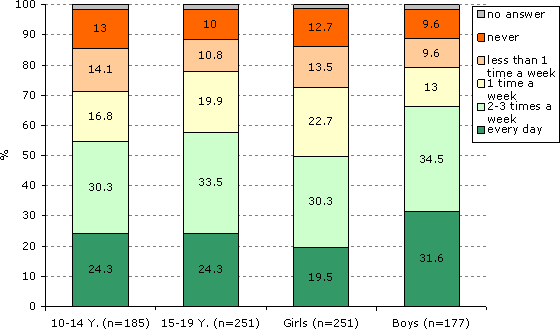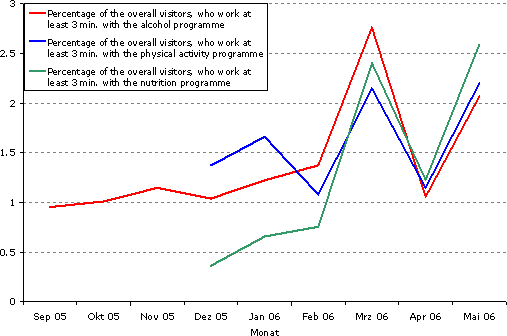11th annual Congress of the EUROPEAN COLLEGE OF SPORT SCIENCE 05-08 July LAUSANNE 2006 - Switzerland
Can inactive and partially active young people be reached through an internet programme to promote physical activity?
Padlina, O. - Gerda Jimmy - Brian Martin
Swiss Federal Institute of Sports Magglingen, Swiss Federal Office of Sports
Institute of Social and Preventive Medicine, University of Zurich
Institute of Social and Preventive Medicine, University of Zurich
Introduction
Feelok is an online health promotion programme for young people aged 12-18 (www.feelok.ch). It has been available since 2002 and includes sections on the following topics: smoking, cannabis, stress, self-confidence, sexuality, physical activity, nutrition, and alcohol. The physical activity section is aimed at inactive and partially active youth and was developed at the Swiss Federal Office of Sports in 2005. The aim of this presentation is to determine whether inactive and partially active young people can be reached through the internet medium and if they show an interest in engaging in the programme.
Feelok is an online health promotion programme for young people aged 12-18 (www.feelok.ch). It has been available since 2002 and includes sections on the following topics: smoking, cannabis, stress, self-confidence, sexuality, physical activity, nutrition, and alcohol. The physical activity section is aimed at inactive and partially active youth and was developed at the Swiss Federal Office of Sports in 2005. The aim of this presentation is to determine whether inactive and partially active young people can be reached through the internet medium and if they show an interest in engaging in the programme.
Methods
Three different sources were used to answer the above question.
- When the section on physical activity had not been added to feelok yet, all visitors of the general feelok programme were asked how many times per week they engaged in sports outside school hours.
- Once the section on physical activity was launched, a programme running in the background of feelok recorded user numbers and duration of visits to this section.
- feelok also offers a physical activity test based on a 7-day recall questionnaire. Test participants were classified as inactive if they accumulated less than 1500 kcal through physical activities during a week and as partially active if the energy expenditure was between 1500 and 2500 kcal.
Results
- The question on sports outside school hours was answered by 436 youths aged 10 to 19 (54% female, response rate 14.2%) during a 2 week time period. About twenty-five percent reported engaging in sports less than once a week or never. For more detail see figure 1.

Figure 1: Answers in % for the question: "Do you get exercise outside the school time?" (n see figure)
- The feelok physical activity promotion programme was visited 3'283 times for at least 3 minutes during a time period of 6 months, which equalled to 40% of all visits to the programme. An average visit lasted 17 minutes. Figure 2 shows how many visitors of feelok decided to work with the physical activity, with the alcohol and with the nutrition programme for at least 3 minutes during a time period of 6 months. On average 1.7% of the visitors of the feelok programme as a whole decided to work with the physical activity programme.

Figure 2: Percentage of visitors, who worked with the physical activity, with the alcohol and with the nutrition programme between September 2005 and Mai 2006. During this time period feelok was visited about 260'000 times.
- Out of 1'401 youths aged 10 to 19 (61.4% female) who completed the physical activity test, 7% were classified as inactive and 12.3% as partially active.
Conclusion
Seeing that a quarter of visitors of the feelok programme as a whole were rarely active in sports, it can be concluded that this kind of programme is a good starting point to reach the group of inactive and partially active youths. The number of 540 visits per month for the physical activity promotion programme is comparable to the use of other health programmes offered as part of feelok and shows that this programme attracted the interest of young people. Among those who completed the physical activity test, nearly 20% were classified as inactive or partially active which indicates that this group can be reached through such an internet programme. However, more active recruitment measures may lead to a higher participation rate of the primary target group.
Seeing that a quarter of visitors of the feelok programme as a whole were rarely active in sports, it can be concluded that this kind of programme is a good starting point to reach the group of inactive and partially active youths. The number of 540 visits per month for the physical activity promotion programme is comparable to the use of other health programmes offered as part of feelok and shows that this programme attracted the interest of young people. Among those who completed the physical activity test, nearly 20% were classified as inactive or partially active which indicates that this group can be reached through such an internet programme. However, more active recruitment measures may lead to a higher participation rate of the primary target group.